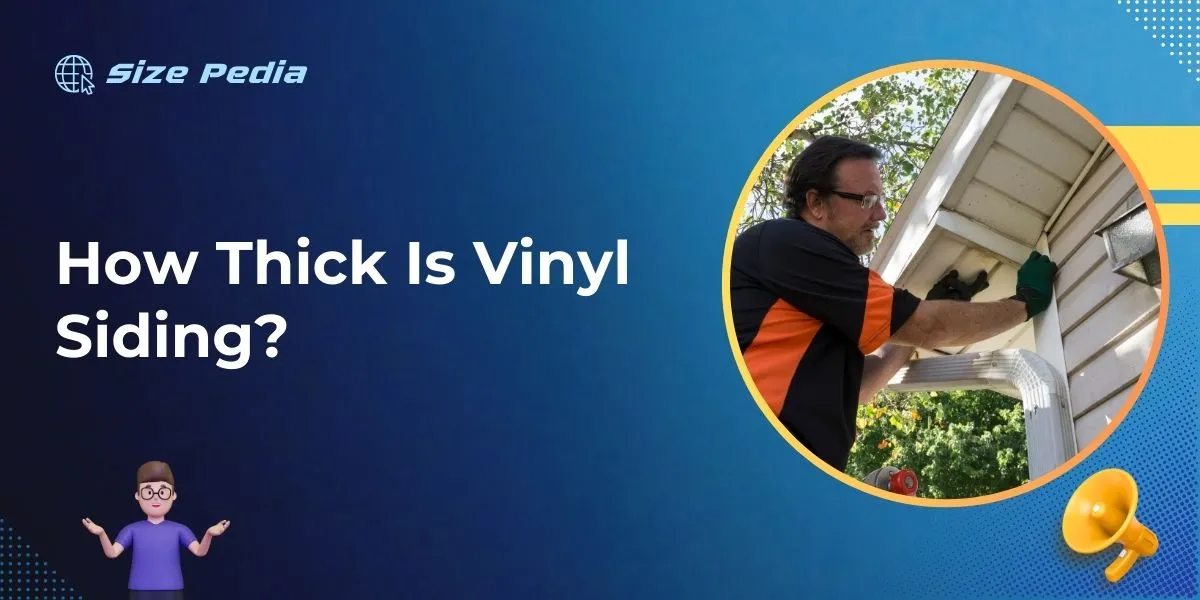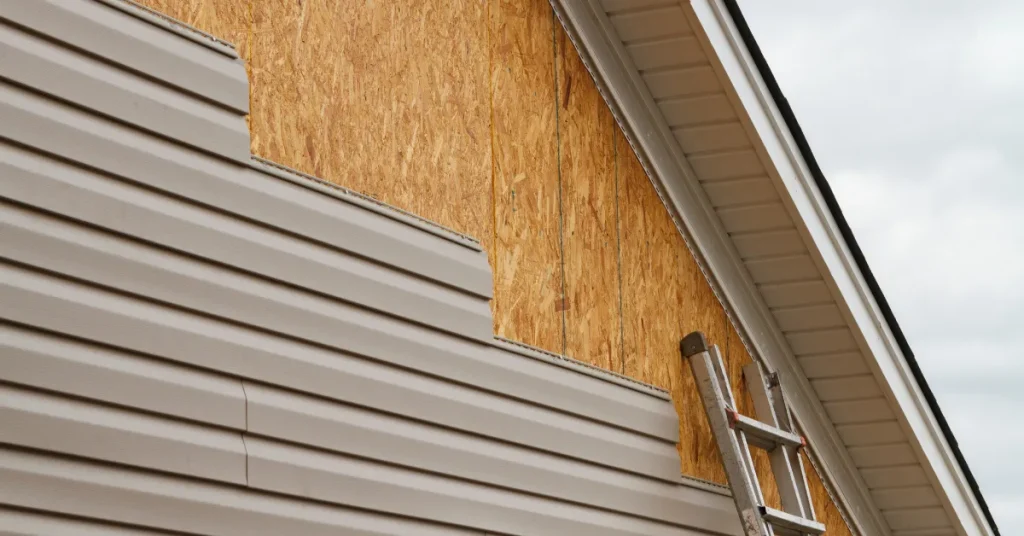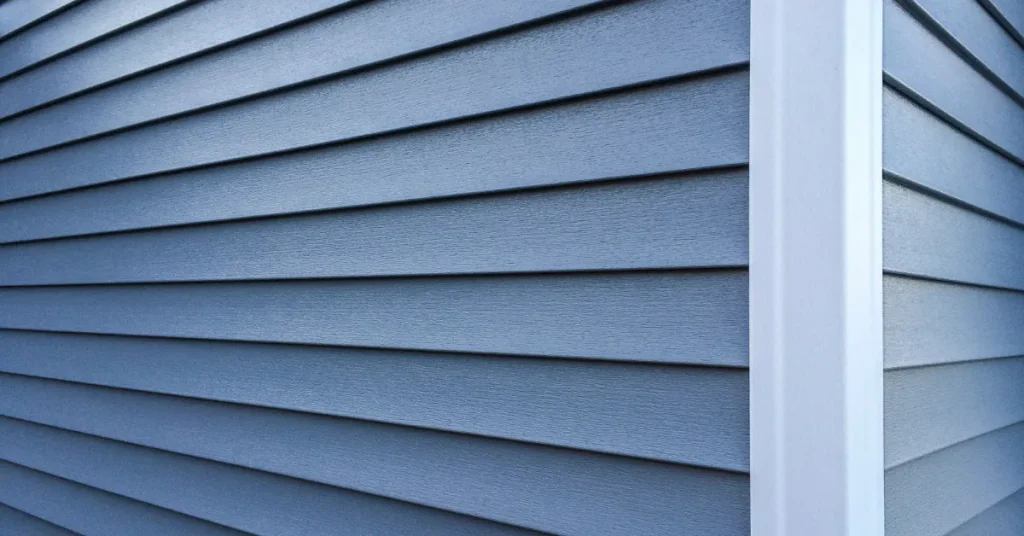Vinyl siding typically ranges in thickness from 0.035 to 0.055 inches. The average residential grade falls around 0.040 inches.
Vinyl siding serves as a durable, low-maintenance option for those seeking to enhance their home’s exterior without frequent upkeep.
Known for its versatility and relatively low cost, vinyl siding provides homeowners with a broad range of colors and textures, mimicking more expensive materials like wood clapboard or stone.
Its thickness can impact durability, insulation properties, and resistance to elements, making it a crucial consideration for those looking to invest in siding.
As the first line of defense against the weather, it is essential to select a thickness that balances cost with performance, ensuring long-lasting protection and visual appeal for your home.

Introduction To Vinyl Siding
Vinyl siding is a popular choice for homeowners. It covers the exterior walls of a house. This siding is known for durability, ease of maintenance, and versatility. Let’s dive into what this material offers and why its thickness matters.
Popularity And Benefits
Vinyl siding tops the charts in home cladding options. It’s loved for its appealing look and color variety. Homeowners often choose it because:
- It’s easy to clean
- Installation doesn’t cost much
- It can handle bad weather
- Energy-efficient styles are available
The Role Of Thickness
The thickness of vinyl siding is essential. It influences how well the siding performs. Thicker siding means:
- Better durability
- Resistance to impacts
- Improved insulation
- A smoother appearance on walls
Thicker siding often comes with longer warranties. This is a sign of quality and trust in the product.
Measuring Vinyl Siding Thickness

Vinyl siding protects and adds flair to your home’s exterior. Its durability often hinges on its thickness.
Proper measurement is crucial to understand its resilience. Whether you’re a homeowner or a professional, knowing how to measure this can guide your buying decisions and maintenance plans.
Units Of Measurement
In the United States, vinyl siding thickness is typically measured in mils. One mil equals one-thousandth of an inch. Thickness can range from 35 mils to premium options above 50 mils. Thicker siding means better quality, impact resistance, and insulation.
Tools For Assessing Thickness
Measuring thickness requires precision. You can use a variety of tools:
- Micrometer: A handheld tool that gives accurate measurements.
- Caliper: Another precision instrument that can gauge the thickness.
- Ruler: Less precise, but can offer a quick estimate.
To measure, take a sample piece of the siding, and use one of the tools above to assess its thickness. Be sure to measure at the butt end where it’s the thickest. Note this value for comparison or quality assessment.
Standard Thickness Ranges
Vinyl siding provides a durable and attractive option for homes. Its thickness can affect both performance and appearance.
Generally, siding thickness ranges from 0.035 inches to 0.055 inches. Let’s delve into the common thickness ranges available in the market.
Entry-level Options
For those on a budget, entry-level vinyl siding is a cost-effective choice. These options usually measure between 0.035 and 0.040 inches. Despite being thinner, they offer a practical solution for home protection.
- 0.035 inches – Lightweight and most economical
- 0.040 inches – Slightly more durable with modest cost increase
Premium Choices
Premium vinyl siding showcases higher quality with increased thickness. These products range from 0.042 to 0.055 inches. They boast enhanced durability and better insulation properties.
- 0.042 inches – Improved rigidity and strength
- 0.046 inches – Strong resistance to impact and weathering
- 0.050 inches – Superior protection and longevity
- 0.055 inches – Top-tier thickness for maximum benefits
| Category | Thickness (inches) | Benefits |
| Entry-Level | 0.035 – 0.040 | Cost-effective, satisfies basic needs |
| Premium | 0.042 – 0.055 | Enhanced durability, better insulation |
Factors Influencing Vinyl Siding Thickness
Factors Influencing Vinyl Siding Thickness play a pivotal role in the durability and insulation capabilities of vinyl siding.
From the way vinyl siding is made to the climate it’s designed for, various elements affect its performance and quality. Understanding these factors ensures a wise choice for any home exterior.
Manufacturing Differences
Vinyl siding comes in various thicknesses, largely determined by the manufacturing process. Producers adhere to different standards and use diverse materials and technologies.
These differences lead to a range in thickness that caters to both budget-friendly and premium options.
Here’s a quick breakdown of how manufacturing processes affect thickness:
- Material Quality: Higher-grade resins result in thicker siding.
- Production Techniques: Advances in technology can create denser products.
- Brand Specifications: Some brands may opt for unique thickness levels to stand out.
Environmental Considerations
Climate plays an outsized role in determining the ideal vinyl siding thickness. Siding must withstand local weather conditions to be effective, hence the variation in product specifications.
Below are key environmental factors to consider:
| Condition | Influence on Thickness |
| Temperature Extremes | Thicker siding offers better resistance to warping and cracking. |
| Wind Load | High winds require sturdier siding to prevent damage. |
| Insulation Needs | Thicker siding provides better insulation, saving energy. |
Correlation Between Thickness And Durability

When choosing vinyl siding for your home, thickness plays a key role. Thick siding means better durability. It stands up against time and weather challenges.
Understanding how thickness affects performance is crucial for your home’s protection.
Impact On Weather Resistance
Thicker vinyl siding offers enhanced weather resistance. It acts as a shield for your home. Thicker siding withstands high winds, heavy rain, and hail far better than thin alternatives. This resilience is vital for homes in areas facing extreme weather conditions.
Key benefits include:
- Protection from wind damage.
- Resistance to cracking in cold temperatures.
- Sturdiness in the face of storms and impacts.
Longevity And Maintenance
Thick vinyl siding lasts longer than thin siding. It resists fading, cracking, and wear over time. This means less maintenance for homeowners. Enjoy more years of a beautiful home exterior with less hassle.
Thick vinyl siding benefits:
| Feature | Benefit |
| Color Retention | Looks newer, longer. |
| Less Prone to Damage | Reduces repair costs. |
| Improved Insulation | Increases energy efficiency. |
Opting for thicker siding secures a robust home exterior. Consider it a smart investment for your property.
Choosing The Right Thickness For Your Home
When it’s time to give your home a fresh, new exterior, choosing the right vinyl siding thickness is crucial.
This choice not only affects durability and insulation but also the overall look and feel of your home. Let’s navigate the options to ensure you make the best decision for your property.
Assessing Your Needs
Understanding local weather conditions is the first step in choosing vinyl siding thickness. If your home faces extreme temperatures or strong winds, then a thicker siding may provide better protection.
- Thinner siding: usually ranges from .035 to .040 inches.
- Standard residential thickness: around .042 to .045 inches.
- Thicker, more premium options: up to .055 inches or more.
Think about your home’s insulation needs. Thicker siding can help keep your home cozy and reduce energy bills. Aesthetics matter too! The siding should complement your home’s design.
Lastly, consider the longevity and maintenance. Thicker siding often withstands wear and tear better, making it a long-lasting investment.
Professional Recommendations
To ensure you’re making an informed decision, seek advice from industry professionals. They bring experience to the table and can recommend specific products tailored to your home’s needs.
| Professional Service | Benefits |
| Installation Expertise | Ensures correct application for maximum durability |
| Insulation Assessment | Helps choose the right thickness for energy efficiency |
| Product Knowledge | Access to the latest and most suitable materials |
Professionals will also take into account the local building codes and manufacturer warranties. This will ensure compliance while securing the benefits of the warranty.
Remember, your home’s siding is its shield against the elements, and it’s a substantial attribute to its curb appeal. So, invest the time and effort to select the vinyl siding that’s just right for you.
FAQs About How Thick Is Vinyl Siding
Is .044 Vinyl Siding Good?
. 044 vinyl siding is considered durable and sturdy, offering good resistance to impact and weather-related stress, making it a solid choice for home exterior cladding.
How Thick Is Insulated Vinyl Siding?
Insulated vinyl siding typically ranges from 1 to 2 inches in thickness, which includes the vinyl exterior and the foam insulation backing.
Who Has The Thickest Vinyl Siding?
Certain vinyl siding manufacturers offer products with enhanced thickness. CraneBoard® Solid Core Siding, with a thickness of 0. 048 inches, stands among the thickest options available for residential applications.
How Thick Is Vinyl Siding Insulation?
Vinyl siding insulation can vary in thickness, typically ranging from 0. 25 inches to 1. 5 inches.
Conclusion
Understanding vinyl siding thickness is crucial for any homeowner seeking durability and quality. Opting for thicker siding often means increased resistance to weather and better insulation.
As you embark on your home improvement journey, remember that a well-chosen siding can protect and beautify your home for years to come.
Choose wisely and invest in the best thickness your budget allows for long-lasting results.
Resources:
1.https://ws680.nist.gov/bees/ProductListFiles/Generic%20Vinyl%20Siding.pdf
